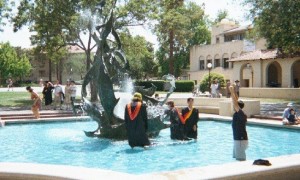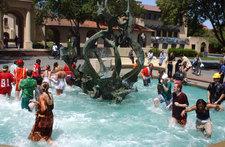Stanford Fountain Hopping
 Fountains are a pleasant piece of scenery. For Stanford students, they are that and so much more. During hot spring days students attending Stanford University are known to play in the fountains around campus, submerging themselves and splashing each other. While it can be done individually, it is most often done in groups with friends. Students often run in a circle around the perimeter of the fountain, creating a whirlpool effect. They most often engage in these activities after sporting events or to celebrate a certain event. Birthdays, sorority or fraternity inductions, the end of finals, graduation – nearly everything that can be celebrated is celebrated by fountain hopping. In the picture included above, students refresh themselves after graduation by jumping in the famous Old Union fountain.
Fountains are a pleasant piece of scenery. For Stanford students, they are that and so much more. During hot spring days students attending Stanford University are known to play in the fountains around campus, submerging themselves and splashing each other. While it can be done individually, it is most often done in groups with friends. Students often run in a circle around the perimeter of the fountain, creating a whirlpool effect. They most often engage in these activities after sporting events or to celebrate a certain event. Birthdays, sorority or fraternity inductions, the end of finals, graduation – nearly everything that can be celebrated is celebrated by fountain hopping. In the picture included above, students refresh themselves after graduation by jumping in the famous Old Union fountain.
My friend Amie, who is a freshman attending Stanford University, shared this little tradition with me. Like me, she is originally from Southern California. We both had no prior knowledge of this strange habit of Stanford students. She explains that although it may be strange outside of Stanford, it is really quite commonplace there. Its not weird here, she adds, everybody does it. Perhaps as a freshman, however, she still thinks it a little strange, and has not indulged in this tradition herself. She has however taken the first  steps, having sat on the edge and put her feet into the water. She adds, Even on hot days, the water is still really cold, I can see why everybody does it. After discussion we concluded that the tradition probably started on a hot day when a quirky individual thought he would take a swim in a fountain. Seeing how much fun he was having and sweating from the scorching heat, others soon joined him. The experience was so gratifying that they indulged themselves over and over again. Seeing this golden opportunity to do something out of the ordinary which is usually frowned upon, even more students decided to join them in the fountain. Soon, so many people were playing the fountains of Stanford that it gradually became a socially acceptable activity to participate in. Indeed, the school does not even condemn this practice.
steps, having sat on the edge and put her feet into the water. She adds, Even on hot days, the water is still really cold, I can see why everybody does it. After discussion we concluded that the tradition probably started on a hot day when a quirky individual thought he would take a swim in a fountain. Seeing how much fun he was having and sweating from the scorching heat, others soon joined him. The experience was so gratifying that they indulged themselves over and over again. Seeing this golden opportunity to do something out of the ordinary which is usually frowned upon, even more students decided to join them in the fountain. Soon, so many people were playing the fountains of Stanford that it gradually became a socially acceptable activity to participate in. Indeed, the school does not even condemn this practice.
After some research, I found that this tradition was documented in the article by Jenny Miller entitled Fountain hopping a popular Stanford Spring Tradition. This piece appeared in the May 24, 2002 issue. It relates how the university has embraced this tradition, with the school band even holding a spring fountain rally every year. According to John Bravman, Vice Provost for Undergraduate Education, this tradition probably originated in the late 1970s and became prominent in the 1980s.
Since I had heard nothing of this event prior to visiting Stanford, I was shocked to see students casually loafing in the schools many fountains in their swimming suits. It was not hard to guess why this tradition caught on so quickly, however. With the temperatures in the high eighties, the only place I really wanted to be was the beach. Having grown up in Hermosa Beach, the beach was a luxury only a ten minute walk away. These poor students had no such oasis of refreshment up in Stanford. The nearest beach required a lengthy car ride and even then, the shore was rocky and uninviting. These fountains, though a poor substitute for sunny Hermosa Beach, were at least a place where they students could relax, cool off, and socialize.
Strangely enough, this was not the first time I had seen individuals playing in a fountain. At the foot of the towering Space Needle in Seattle, Washington, there lies the sprawling Seattle Center. In this center is the largest fountain in Seattle, the International Fountain. Pictured below, this fountain was designed for children and adults alike to play in its delightful water streams. With a large bowl shaped bottom and varying streams of water shooting from the center, it can accommodate massive amounts of people at once.  Indeed, when I visited with a couple of friends on a road trip we took last summer, there were probably close to fifty happy individuals running around in the water. The excitement is contagious; though none of us were dressed in anything remotely resembling swimwear, we all jumped in a joined the crowd. The demographics of the attraction were interesting; it seemed as if people from every walk of life were present. Wealthy tourist families on vacation with their children were present. Poorer families, probably from a neighboring area, were also there. Neighborhood children riding bikes came to play in the water. High school age children and young adults alike found themselves running around in the fountain. Even retired seniors came to the fountain. While most of these probably came to sit and watch the youngsters play, a couple of them joyously slipped into the water themselves. It seems that whether in Hermosa Beach, Stanford, or Seattle, people enjoy a socializing and playing in the water on sunny days.
Indeed, when I visited with a couple of friends on a road trip we took last summer, there were probably close to fifty happy individuals running around in the water. The excitement is contagious; though none of us were dressed in anything remotely resembling swimwear, we all jumped in a joined the crowd. The demographics of the attraction were interesting; it seemed as if people from every walk of life were present. Wealthy tourist families on vacation with their children were present. Poorer families, probably from a neighboring area, were also there. Neighborhood children riding bikes came to play in the water. High school age children and young adults alike found themselves running around in the fountain. Even retired seniors came to the fountain. While most of these probably came to sit and watch the youngsters play, a couple of them joyously slipped into the water themselves. It seems that whether in Hermosa Beach, Stanford, or Seattle, people enjoy a socializing and playing in the water on sunny days.
